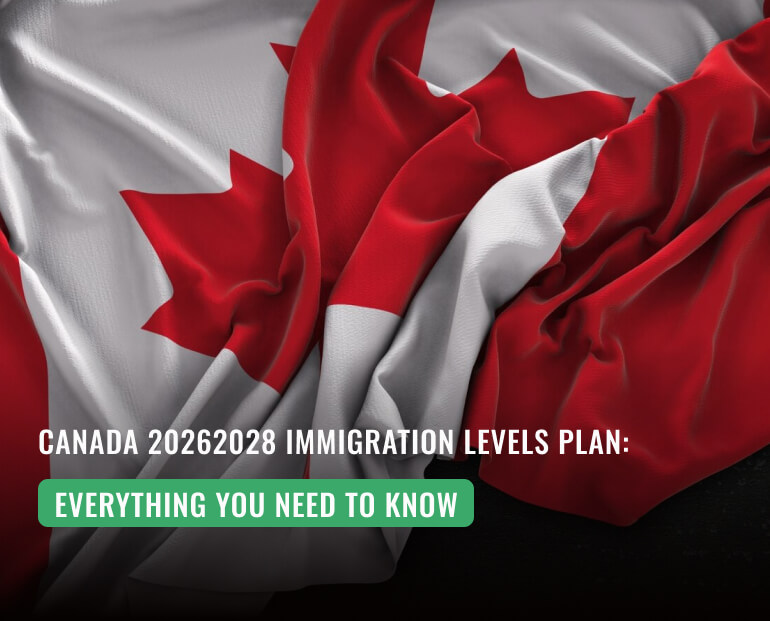Canada is one of the most popular destinations for people from Qatar who want to work, study, or live abroad. It is known for its strong economy, high-quality education, and welcoming environment for immigrants. Every year, Canada plans how many people it will allow to enter the country to manage population growth and support the economy.
Recently, the Canadian government has released its 20262028 Immigration Levels Plan. It highlights the number of people Canada is planning to accept each year and highlights a shift in focus from temporary residents to permanent residents. If you are living in Qatar and considering moving to this country, you need to understand these changes to choose the right immigration path.
In this blog, we will explain the new plan, highlight the key changes, and explain how it affects different groups.
An Overview of Canada’s 2026-2028 Immigration Plan
The Immigration Levels Plan is a roadmap for how Canada manages the number of people entering the country each year. It covers both temporary residents (TR), such as workers and students, and permanent residents (PR).
One of the main goals of the 20262028 plan is to move more temporary residents to permanent status. It means that Canada wants people who are already in the country on work or study permits to have a clear path to becoming permanent residents. This shift will help in maintaining a stable population and improving the integration of immigrants. The plan also focuses on economic immigration, which includes skilled workers who can contribute to the country’s economy. Apart from that, refugee protection has also remained a key part.
Key Changes in the 2026-2028 Plan
It introduces several important changes compared to previous years. Understanding them is crucial for anyone planning to move to Canada from Qatar or any other country. Some noticeable highlights are listed below.
Reduced Number of Temporary Residents
It targets around 385,000 temporary residents in 2026, 370,000 in each of the next 2 years. It is 43% less than the total number of TR (673,650) allowed in 2025. It means competition may increase for those looking to enter Canada on a study or work permit.
Stable PR Numbers
The annual target for permanent residents is 380,000 for each year from 2026 to 2028. Economic immigrants will share the largest part of this number. It means there will be better opportunities for individuals who qualify for the skilled immigration pathways.
Family reunification is still a priority, as 84,000 immigrants are allowed under this category in 2026 and 81,000 in 2027, 2028 each. More than 50,000 refugees and protected persons are also allowed in each year to make sure Canada meets its humanitarian obligations.
Shift to Economic Immigration
This plan increases the proportion of economic immigrants from 59% to 64%. It shows that the country is focusing on attracting skilled workers who can contribute to the economy. Moreover, up to 33,000 work permit holders will get PR between 2026 to 2027. If you have work experience in high-demand fields, you can have better opportunities to gain permanent residency in Canada.
New Policies for TR to PR Transition
Canada is giving special importance to programs that allow temporary residents to become permanent residents. The new plan highlights the Canadian Experience Class, Express Entry, and some new measures for TR to PR transitions.
Lower Share for Students
There’s almost a 50% decrease in international student admissions. Canada is expecting to give permits to around 155,000 learners in 2026. This number was 305,900 in 2025.
Why Canada is Focusing on TR to PR Transition
Moving temporary residents to permanent residents is a part of a strategy to improve integration and stability. The key reasons for this change are:
Economic Stability
The Canadian government wants people who stay longer to contribute consistently to the economy. Permanent residents spend, work, and pay taxes over time. It provides stability for businesses, communities, and government programs. It ensures a reliable workforce that supports economic growth and reduces dependency on short-term labor.
Better Planning
Focusing on permanent residents allows Canada to plan healthcare, education, and housing more effectively. Temporary residents leave after a certain period, which makes planning difficult. Meanwhile, PR holders provide predictable population growth. It helps local communities manage resources efficiently and ensures that newcomers have access to the services they need to settle and succeed in Canada.
Promoting Integration
Permanent residents have better access to community programs, education, and job opportunities. This helps them settle better and feel part of Canadian society. On the other hand, temporary residents may face limits on work, study, or social services, which can make integration harder.
Skilled Workforce
Many temporary workers gain Canadian experience, which makes them ideal candidates for permanent residency. These individuals understand the work environment, culture, and expectations. By converting experienced workers into permanent residents, Canada strengthens its skilled workforce.
How These Changes Affect Different Groups
The 20262028 plan impacts various groups in different ways. Understanding these effects can help you plan your immigration path more effectively.
Students
The changes in the immigration plan may affect students differently than in previous years. With a reduction in the number of new study permits, competition for admission will increase. However, studying in Canada remains a strong pathway to permanent residency. If you gain Canadian work experience during or after your studies, you can use the Canadian Experience Class to transition from temporary status to permanent residency.
Skilled Workers
They have more clearly defined pathways to permanent residency. Express Entry and Provincial Nominee Programs are now more aligned with temporary-to-permanent transitions, making Canadian work experience highly valuable. It means securing a temporary work position in Canada can be a strategic step toward PR.
Families
Family reunification is an important part of Canada’s immigration strategy. If you are already in Canada, you can sponsor close family members to stay together. If you plan properly, your spouses, children, or other eligible family members can join you in Canada smoothly.
Employers and Businesses
They may experience changes in how they hire foreign workers due to the overall reduction in temporary resident numbers. Companies are now encouraged to focus on candidates who are already in Canada or who can transition to permanent residency.
TR to PR Pathways
Since this program is focusing on the TR to PR shift, you must understand programs that allow temporary residents to become permanent residents. The most relevant pathways under the 20262028 plan are:
Express Entry: It is a points-based system for skilled workers. Candidates are scored based on education, work experience, language ability, and Canadian experience. Express Entry provides a fast and structured pathway from temporary status to permanent residency for qualified individuals.
Canadian Experience Class (CEC): It is suitable for temporary workers and international students who have Canadian work experience. Applicants with at least one year of skilled work in Canada can apply for the Canadian Experience Class. This program values local experience, which makes it an ideal to PR for those who have been working in Canada for some time.
Provincial Nominee Programs(PNP): It allows Canadian provinces to nominate candidates for permanent residency based on local labor needs. Many PNP streams are now aligned with TR to PR pathways.
Conclusion
Canada’s 2026-2028 Immigration Levels Plan focuses on moving temporary residents to permanent status. It is prioritizing skilled workers and families. If you are in Qatar and want to know more about this plan, DM Consultants can guide you. Apart from that, you can also get assistance to apply for temporary residence permits under skilled immigration and other programs.



